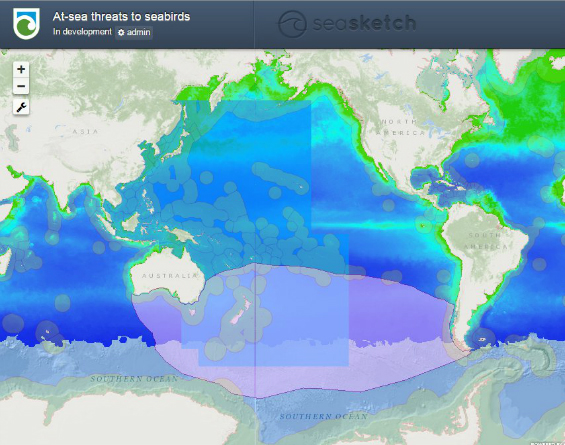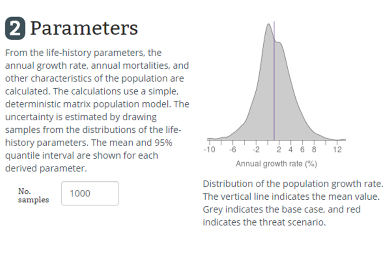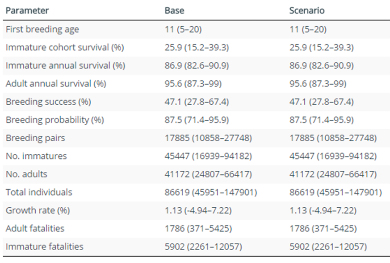Components of the seabird prioritisation framework
Introduction
Read about the tools that make up the seabird prioritisation framework.Seabird population and demographic database
This component will provide an inventory of pertinent population metric data, and records of at-sea and land-based threats to these seabirds identified to date.

A Buller's albatross marked for census
Building on historic reviews, the database will inform technical staff, and others, on the extent of information available on New Zealand seabirds and the threats to them.
The resource is intended to be useful for various activities including conservation management planning and prioritisation, risk assessments, research and identifying critical data gaps.
Currently the database can only be accessed within DOC, but options to allow a web-based interface are being investigated.
Spatial mapping tool for seabird distribution and at-sea threats
New Zealand seabirds are global travellers. Visualising and assessing the foraging distribution of seabirds, and their overlap with at-sea threats forms a central component of the framework.
The participatory marine spatial planning tool SeaSketch is being used to develop an interactive mapping project as part of the framework. This will allow a range of spatial data to be displayed and overlaid.
A trial SeaSketch project is available for registered users to view distribution data on New Zealand breeding albatrosses, together with a range of at-sea threat and environmental data.
Work is continuing to identify potential at-sea threats, source data on the spatial extent of those threats, and assess their potential impact on seabirds. View the seabird SeaSketch project.
Note: this project is currently in the development stage, and is populated with data relevant to New Zealand breeding albatross species. The project is being provided to demonstrate the utility of such a mapping tool to better understand at-sea threats, and prioritise research and conservation management actions, and is not intended for other uses. Full access to the project requires registration and approval by DOC. To register your interest in this project, or for any queries, contact DOC at marine@doc.govt.nz

An example overlay plot using SeaSketch
Tools to facilitate expert review and input
The extent and quality of existing data on the biology and distribution of seabirds is highly variable. In order to conduct comparable risk assessment across all seabirds it is necessary to establish an agreed set of inputs, such as estimates of demographic parameters and key foraging areas.
To achieve this, existing data must be expert reviewed, and in some cases supplemented with expert opinion. Two facilitation processes are being developed as tools in the framework:
- Expert online survey. A two-step Delphi survey was developed to engage experts in the review of population data collated in the database, and reach consensus on a set of inputs for the risk assessment tool. The Delphi method is a structured survey technique for gathering quantitative information and obtaining consensus estimates from a panel of experts. A report is available that describes the development and trial of the survey on albatross taxa: Evaluating threats to New Zealand seabirds (PDF, 560K).
- SeaSketch sketches. SeaSketch provides a platform to enable the input, sharing and review of spatial data. A process is being developed to allow relevant experts to review existing seabird distribution data and define (sketch) key areas in which to assess the overlap and impact of at-sea threats.
Risk assessment tool
A simple matrix model was developed to allow seabird population growth rates to be estimated for a wide range of species using the population parameters derived from the expert survey process.
The tool is made available as a demographic modelling website. This online application allows users to assess how changes in demographic parameters affect changes in seabird populations. In particular, it may be used to assess how threats that impact on seabird demographic parameters affect the population trajectories of seabirds. Uncertainty in parameter estimates can also be investigated by manipulating the input parameters.
A report (PDF, 560K) is available that describes the development of the tool.
The tool is available online for evaluation purposes, populated with input data for albatross taxa derived from the expert survey. View the risk assessment tool.

The parameters section of the matrix population model

View the effects of a scenario on the parameters of a population
